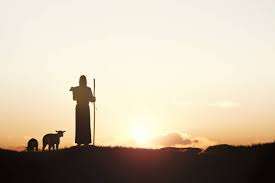

Shepherd imagery in the NEW Testament
Pr. Phinny Kuruvilla
Shepherd is one of the major imageries that found in the bible. In the Old Testament there are strong warnings against bad shepherds, also prophecies of a good shepherd is going to come. In the New Testament Jesus declared that he is the good Shepherd. In the epistles we find those who lead the church are known as shepherd.
In the Ancient Near East, shepherding was considered as one of the oldest of human occupations. It was not only an occupation, but also an economic foundation of the societies. The shepherds herding the flock may not necessarily be owners of the flock. They could simply be hired by the owner; for example, Genesis 29-30 where Jacob was hired by Laban to pasture his sheep. In all probability those who hired to care for herds did not always care for them as the owner would. Thus, we have the distinction between the good shepherd and the bad shepherd.
The Greek noun form for shepherd poimh,npoimēn occurs eighteen times in the New Testament, mostly in the Gospels. Apart from the Gospel it appears once in Ephesians 4:11, Hebrews 13:20, and 1 Peter 2:25. In the Gospels, it is found thrice in Matthew (9:36; 25:32; 26:31), twice in Mark (6:34; 14:27), four times in Luke (2:8, 15, 18, 20), six times in John (10:2, 11a, 11b, 12, 14, 16). Only in Ephesians 4:11 poimh,npoimēn is translated as pastor. The verb form poimainwpoimain ōoccurs in Matthew 2:6; Luke 17:7; John 21:16; Acts 20:28; 1 Corinthians 9:7; 1 Peter 5:2; Jude 1:12; Revelation 2:27, 7:17, 12:5, 19:15.
Shepherds were expected to carefully watch for enemies either as wild animals or as thieves. Since sheep is an easy prey for wild animals, shepherds had to constantly care and keep watch on their herds (cf., 1 Sam. 17:34-35). Because of the dangers one had to face, hired shepherds sometimes chose to save their own lives rather than risk themselves for their flocks. But in the Gospel of John we finds an example of the good shepherd lays down his life for the sheep (John 10:11-13). The good shepherd‘s primary duties are to guide, provide food and water, protect and deliver, gather back to the herd that were lost, to nurture and provide security.
Shepherd in the New Testament
The shepherds that are referred in the gospel of Luke chapter 2 is in the context of the birth of Jesus Christ are the shepherds of the sheep (Luke 2:8-20). Whereas, in the other Gospels the usage of ‘the shepherd’ (Matt. 26:31; John 10:2), ‘the good shepherd’ (John 10:11, 14), ‘the one shepherd’ (John 10:16) all refer to Jesus Christ. In the epistles of Hebrews and 1 Peter, the occurrences of the usage ‘the great shepherd’ (Heb. 13:20), ‘the shepherd’ (1 Pet. 2:25), the Chief shepherd (1Pet. 5:4), all these refer to Jesus Christ. In Matthew 9, Jesus is portrayed as one who is having compassion on his people as sheep without a shepherd.
Shepherd in the gospels
Gospel of Luke chapter 15 presents the parable of the lost sheep where Jesus expresses the joy of a shepherd when he finds his sheep after a difficult search (Luke 15:4-7). This shepherd imagery is presented here to show the rejoicing that accompanies the repentance of a sinner. The shepherd would leave the ninety-nine who were on the right path in order to search for the one lost sheep. The shepherd‘s care for the flock of Israel is expanded in Luke to include tax collectors and sinners (Luke 15:1; cf., Matt. 9:10). In The Gospel of Matthew the image of the shepherd and the flock is to illustrate the eschatological judgment. Similar to a scattered flock the nations are assembled around the glorious throne of the Son of Man (Matt. 25:3ff.). Here the process of judgment is compared to the separation of the sheep from the goats.
Jesus the good Shepherd
In John 10 Jesus declared that he is the good shepherd. The good shepherd is sacrificial; He is willing to ignore his own needs in order to meet the needs of the sheep. Jesus continually in the passage states that the good shepherd gives his own life for his sheep (John 10: 11, 15, 17, 18). In addition to this, Jesus portrayed the sacrificial nature of the shepherd in the discussion of the sheepfold. Sheep were normally penned at night outside the city and the shepherd himself would often construct a temporary fold with one small entrance. The shepherd himself would lie across the entrance and become the door of the sheepfold. By doing this shepherd sacrifices his own comfort and sleep to the comfort and safety of the sheep. Jesus finalizes the notion of the sheep’s security by stating John 10:28-29, that with Him they are eternally secure.
Jesus the incarnate Son of God is presented as the promised good Shepherd (John 10:1-21), in contrast to the Pharisees and Sadducees as wicked shepherds. The wicked shepherds are not at all concerned with the troubles and vulnerability of the sheep, rather they made use of the flock for their own personal gain. In this context Jesus is presented as the good Shepherd, showed his selfless love for the flock by dying for them. Jesus had fulfilled this prophetic role in his first coming. He will complete it in his second coming when he comes in judgment to separate the righteous from those who did not know Him, and to finally care and lead those that are his own.
Another characteristic of the good shepherd is that the good shepherd is closely involved with all his sheep. His closeness with the individual sheep is clear in John 10:3, where it says he calls them by name. The shepherd is also involved enough with his flock that they know his voice. The good shepherd showed great concern for his sheep. He provided for them in terms of nourishment and rest. He guided them, leading the way and was intimately involved with the flock and concerned for their safety.
Jesus wanted us to be the Shepherd
This is the kind of love and care which Jesus wanted the leadership of the church to show to their sheep. It was in this context that Jesus challenged Apostle Peter to prove his love after his betrayal (John 21:15-17). After each time Peter expressed his love towards Him, Jesus said, “Tend My lambs” (v.15), “Shepherd my sheep” (v.16), and “Tend my sheep” (v.17). Later at the last part of his life, Peter exhort the elders of the churches in the Asia Minor that, “Be shepherds of God’s flock that is under your care, watching over them—not because you must, but because you are willing, as God wants you to be; not pursuing dishonest gain, but eager to serve;not lording it over those entrusted to you, but being examples to the flock” (1 Pet. 5:2-3). Peter also reminded the shepherds in the church that they would answer one day to their Chief Shepherd – Jesus Christ (1 Pet. 5:4), because He wants to know what they did with His flock.It is important for shepherds/pastors to realize that they are not leading their sheep but Jesus’ sheep. He is the Shepherd and the Overseer (1 Pet. 2:25).
In Matthew 25:32-34, we see an eschatological aspect, “And all the nations will be gathered before Him; and he will separate from one another, as the shepherd separates the sheep from the goats; And He will put the sheep on His right, and the goats on the left.” In this passage the shepherd goes on to direct the sheep to the kingdom prepared from the foundation of the world, and the goats, to eternal punishment. The metaphor here relates to the fact that often a shepherd tended a mixed flock of both sheep and goats. But there will be a time coming when the two groups needed to be separated. This passages teaches that the good Shepherd will come to judge between the individuals at the end of the age. For those who belongs to Himwith the words of comfort and for those who are not, with the words of punishments.
In conclusion all the ministers of Christ are to be right shepherds to their flocks. In Acts 20:28, the Apostle Paul exhorts the Ephesian elders that, “Keep watch over yourselves and all the flock of which the Holy Spirit has made you overseers. Be shepherds of the church of God, which he bought with his own blood.”In Revelation 7:17, when the saints who come out of the tribulation are brought before God, John brings together two of the most striking images of the scripture by stating, “for the Lamb in the centre of the throne shall be their shepherd and shall guide them to springs of the water of life; and God shall wipe every tear from their eye.” May God help all of us to discharge the duties of aright shepherds in the presence of the chief shepherd Jesus Christ


